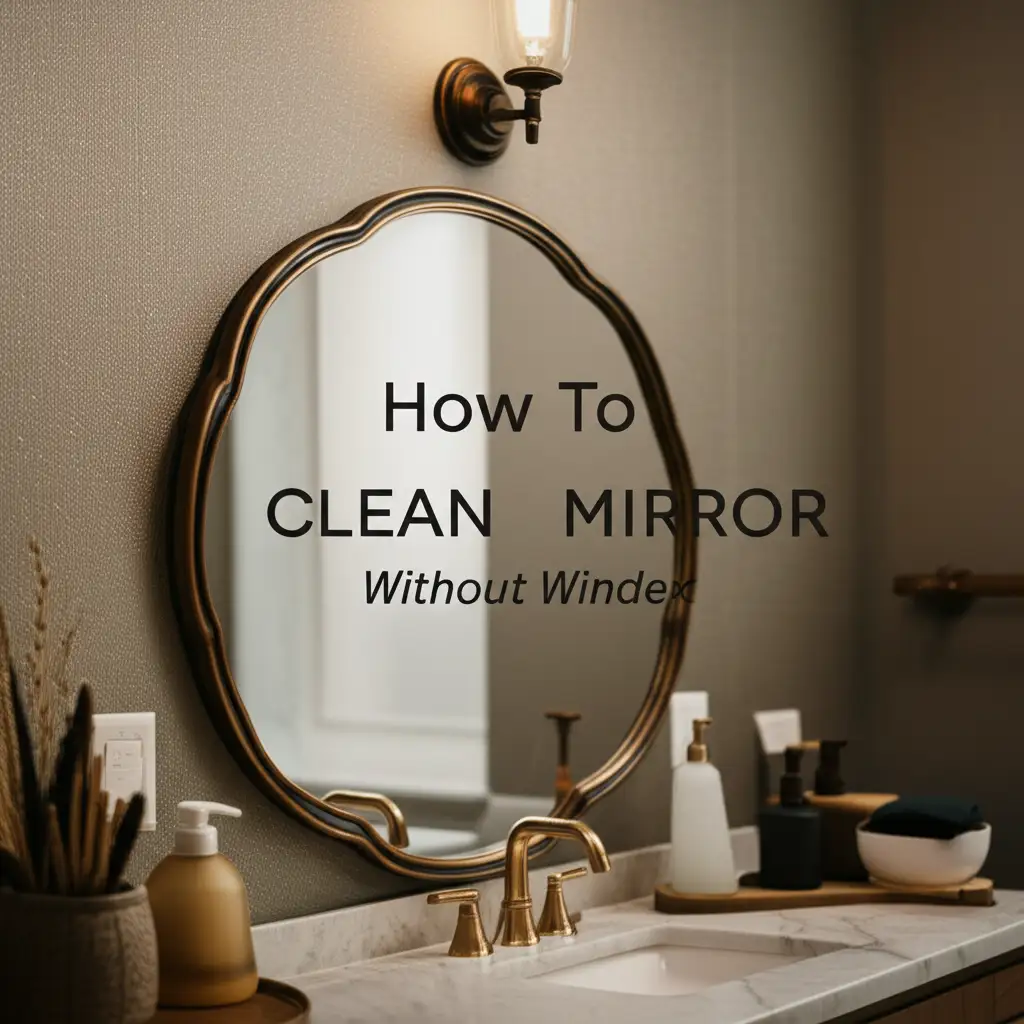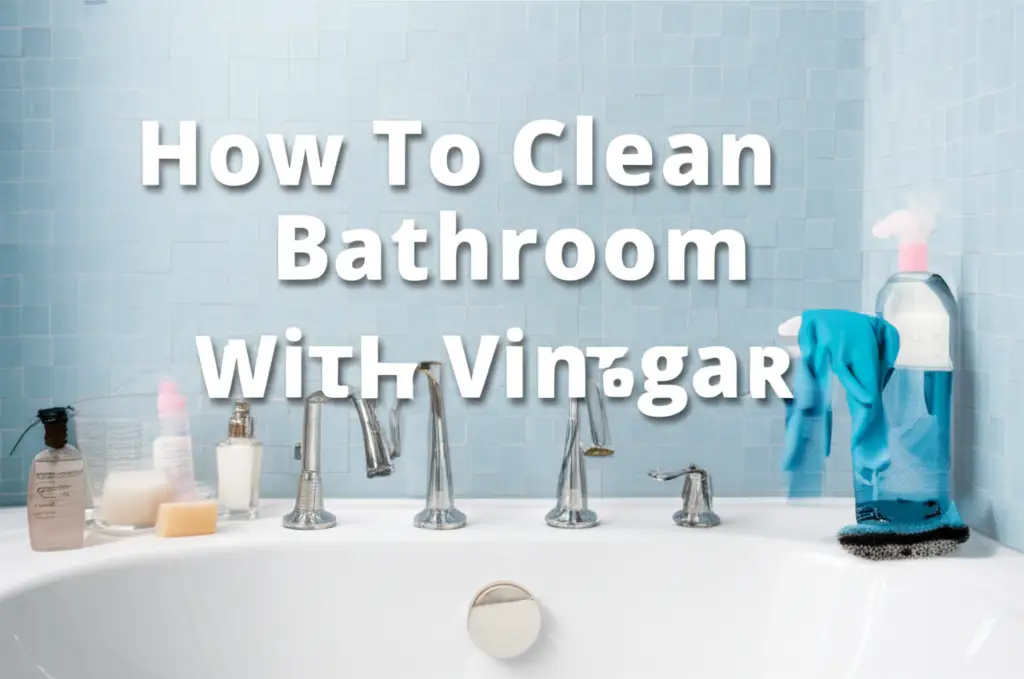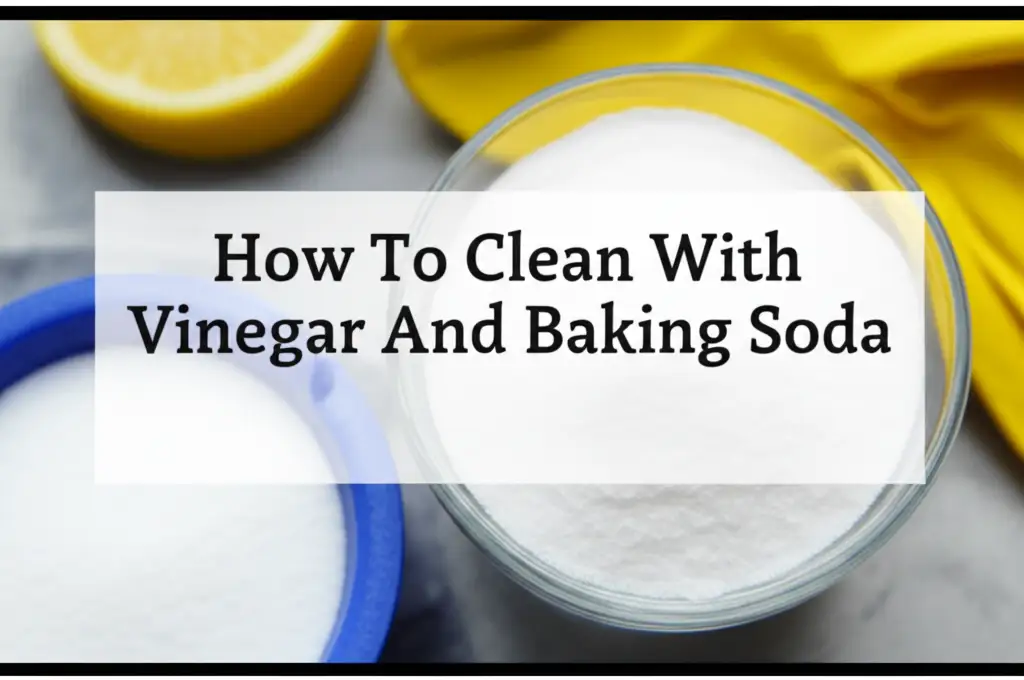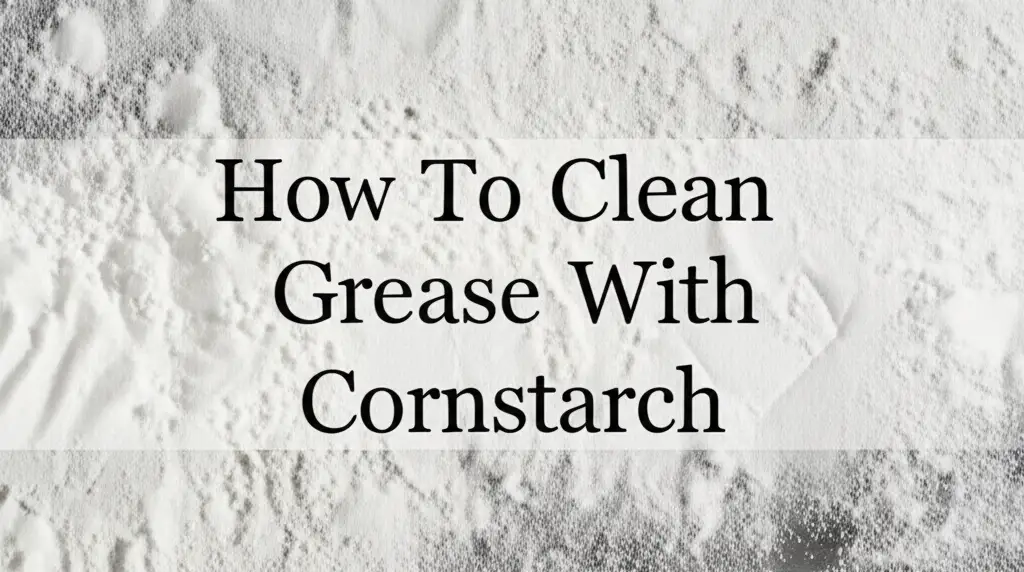· Home Cleaning · 13 min read
How To Clean Mirror Without Windex

How To Clean Mirrors Without Windex: A Guide to Streak-Free Shine
Do you stare at your mirrors only to see frustrating streaks and smudges? Many people reach for traditional glass cleaners, but these often leave residues or contain harsh chemicals. I discovered that you do not need those products for perfectly clean mirrors. You can achieve a sparkling, streak-free surface using common household items.
This guide shares effective, natural methods for mirror cleaning. We will explore simple solutions, essential tools, and helpful techniques. You will learn to clean mirrors safely and efficiently, ensuring clear reflections every time. Say goodbye to streaks and hello to natural shine.
Takeaway
- Avoid Streaks: Use microfiber cloths or crumpled newspaper.
- Choose Natural Cleaners: Vinegar, rubbing alcohol, and dish soap are effective.
- Use Proper Technique: Wipe from top to bottom, buff dry for best results.
You can clean mirrors effectively without Windex by using natural alternatives like white vinegar, rubbing alcohol, or diluted dish soap. Combine these solutions with a high-quality microfiber cloth or crumpled newspaper. This method prevents streaks and leaves mirrors sparkling clean.
Why Choose Alternatives to Commercial Glass Cleaners?
Many commercial glass cleaners promise a streak-free shine. However, they often contain chemicals that can leave behind a film. This film attracts dust and creates an unclear surface. Some ingredients also pose health or environmental concerns. I prefer methods that are safe for my home and the planet.
Moving away from these products offers many benefits. You reduce chemical exposure in your home. This is good for family members and pets. It also helps the environment by lowering chemical runoff. Plus, you save money by using items you likely already own. Natural cleaning solutions work just as well, if not better.
Commercial cleaners often contain dyes or fragrances. These can leave residue on mirrors. The residue makes cleaning more difficult over time. Natural solutions typically evaporate cleanly, leaving no unwanted film. This means your mirrors stay cleaner for longer. Making the switch is a smart choice for a healthier, cleaner home.
Essential Tools and Materials for Mirror Cleaning
Before you start cleaning, gather your supplies. The right tools make a big difference in achieving a streak-free finish. You do not need many specialized items. Most of these are basic household goods. Using the correct materials prevents damage and ensures an effective clean.
First, you need a spray bottle. This helps you apply cleaning solutions evenly. A small, hand-held bottle works best. Next, choose your cleaning cloths. Microfiber cloths are excellent for mirrors. They pick up dirt and moisture without leaving lint. You can also use old cotton T-shirts or newspaper.
For cleaning solutions, you will want white vinegar, rubbing alcohol, or a gentle dish soap. Distilled water is important. Tap water can contain minerals that cause streaks. Having a bucket for rinsing cloths is also useful. Ensure all your tools are clean before you begin. This prevents transferring dirt back onto the mirror.
- Spray Bottle: For even application of cleaning solutions.
- Microfiber Cloths: Ideal for lint-free, streak-free drying.
- Clean Cotton Cloths or Newspaper: Good alternatives for buffing.
- White Vinegar: A natural, effective cleaning agent.
- Rubbing Alcohol (Isopropyl Alcohol): Helps cut through grime and evaporates quickly.
- Gentle Dish Soap: Useful for greasy residues.
- Distilled Water: Prevents mineral streaks.
- Small Bucket: For mixing solutions or rinsing cloths.
The White Vinegar Method for Spotless Mirrors
The white vinegar method is my personal favorite for streak-free mirrors. Vinegar is acidic, which helps break down grime and hard water spots. It also evaporates quickly, leaving no residue. This method is simple, effective, and very affordable. I always have white vinegar on hand for cleaning. You can use it in many ways around your home. For example, it is great for cleaning mold with vinegar.
To prepare your solution, mix equal parts white vinegar and distilled water in a spray bottle. For example, use one cup of vinegar and one cup of water. You can add a few drops of essential oil, like lemon or tea tree, if you dislike the vinegar smell. This helps make the cleaning experience more pleasant. Shake the bottle well to combine the ingredients.
Now, spray the mirror surface evenly. Do not oversaturate the mirror. A light mist works best. Immediately wipe the mirror using a clean microfiber cloth. Wipe from top to bottom in overlapping strokes. This technique ensures you cover the entire surface and prevents streaks. For extra shine, buff the mirror with a dry part of the cloth or crumpled newspaper. This final step removes any remaining moisture or residue. This method will help you clean glass without streaks every time.
Steps for the White Vinegar Method:
- Prepare Solution: Mix equal parts white vinegar and distilled water in a spray bottle. Add essential oil if desired.
- Mist Mirror: Lightly spray the entire mirror surface.
- Wipe Down: Use a clean microfiber cloth to wipe from top to bottom in overlapping strokes.
- Buff Dry: Finish by buffing with a dry portion of the cloth or crumpled newspaper for a perfect shine.
Using Rubbing Alcohol for a Quick Clean
Rubbing alcohol is another excellent choice for cleaning mirrors without Windex. It evaporates very quickly, which means less chance of streaks. Alcohol also disinfects surfaces, killing germs and bacteria. This method is perfect for bathroom mirrors where germs can accumulate. I find it especially effective for quick touch-ups or removing stubborn smudges.
To use rubbing alcohol, you do not need to dilute it. Pour a small amount directly onto a clean microfiber cloth. Do not pour it directly onto the mirror, as it can drip. Use a small amount of alcohol on the cloth. This prevents excess moisture and speeds up drying.
Wipe the mirror surface with the alcohol-dampened cloth. Use firm, even strokes. Work in sections if your mirror is large. The alcohol will evaporate almost instantly, leaving a clean, streak-free surface. This method is especially good for removing hairspray residue or toothpaste splatters. It leaves mirrors sparkling without much effort. Rubbing alcohol is a powerful cleaner for many surfaces.
Steps for the Rubbing Alcohol Method:
- Prepare Cloth: Pour a small amount of rubbing alcohol onto a clean microfiber cloth.
- Wipe Mirror: Use the damp cloth to wipe the entire mirror surface.
- Let Air Dry: The alcohol evaporates quickly, leaving a streak-free finish. No buffing is usually needed.
The Dish Soap Solution for Greasy Residue
Sometimes mirrors get greasy or have tough film. This often happens in kitchens or bathrooms. Standard cleaning solutions might struggle with these types of residues. This is where a simple dish soap solution comes in handy. Dish soap is designed to cut through grease effectively. It provides a gentle yet powerful cleaning action. I use this method when other options do not fully clean the mirror.
To create your dish soap solution, fill a spray bottle with warm distilled water. Add just one or two drops of a mild dish soap. Use very little soap. Too much soap will create excessive suds and leave streaks. Gently swirl the bottle to mix the soap and water. Do not shake it vigorously, as this creates too many bubbles.
Spray the soapy solution onto the mirror surface. Make sure to cover the entire area with a fine mist. Then, wipe the mirror thoroughly with a clean, damp microfiber cloth. After cleaning, take a second clean cloth dampened with plain distilled water. Wipe the mirror again to rinse off any soap residue. Finally, buff the mirror dry with a clean, dry microfiber cloth or newspaper. This rinsing step is crucial to avoid streaks from the soap. This method is very effective for stubborn grime.
Steps for the Dish Soap Method:
- Prepare Solution: Add 1-2 drops of mild dish soap to a spray bottle filled with warm distilled water. Swirl gently.
- Spray Mirror: Lightly mist the mirror surface with the soapy water.
- Clean: Wipe the mirror thoroughly with a clean, damp microfiber cloth.
- Rinse: Wipe again with a cloth dampened with plain distilled water to remove soap.
- Buff Dry: Use a dry microfiber cloth or crumpled newspaper to buff the mirror to a shine.
Advanced Tips for a Perfect, Streak-Free Finish
Achieving a truly streak-free mirror goes beyond just the cleaning solution. Proper technique and specific tools make a significant difference. I have learned these advanced tips over time, and they guarantee a perfect shine. These steps apply to any cleaning method you choose. They elevate your cleaning results.
First, consider the type of cloth you use. Microfiber cloths are superior for mirror cleaning. They are highly absorbent and lint-free. This means they pick up all moisture and dirt without leaving fuzzy bits behind. Always use clean cloths. Dirty cloths will just spread existing dirt or lint. If you do not have microfiber, crumpled newspaper is an excellent alternative. The ink in newspaper helps repel dirt and leaves no lint. Avoid paper towels, as they often leave fibers and can scratch surfaces.
Second, master your wiping technique. Always wipe in one direction, typically from top to bottom. Overlapping strokes ensure you cover every part of the mirror. After cleaning, use a separate, dry cloth for buffing. This step is crucial. Buffing removes any lingering moisture or residue, revealing a crystal-clear surface. Imagine you are polishing glass, not just drying it. Good airflow in the room also helps the mirror dry faster and prevents moisture streaks. Remember, a perfectly clean mirror reflects light beautifully.
- Use High-Quality Microfiber: Opt for clean, lint-free microfiber cloths.
- Newspaper Alternative: Crumpled black-and-white newspaper for a lint-free buff.
- Wiping Technique: Wipe in consistent, overlapping strokes from top to bottom.
- Buffing is Key: Use a separate, dry cloth to buff the mirror to a shine after cleaning.
- Good Ventilation: Ensure good airflow in the room to aid drying.
Troubleshooting Common Mirror Cleaning Issues
Sometimes, even with the best methods, you might encounter issues. Streaks, lingering film, or missed spots can be frustrating. I have faced these problems too. Knowing how to troubleshoot them helps you achieve a truly clean mirror. It is about understanding the root cause of the problem.
Streaks: The most common problem is streaks. Streaks happen for several reasons. You might use too much cleaning solution. Excessive liquid leaves residue. Another cause is using a dirty cloth. A cloth saturated with dirt or old cleaner will just spread grime around. Hard water also leaves streaks. This is why distilled water is always better than tap water. If you see streaks, re-spray the affected area lightly and wipe immediately with a fresh, dry microfiber cloth. Buffing vigorously often helps remove existing streaks.
Lingering Film or Haze: This usually means there is residue left on the mirror. Too much soap, using commercial cleaners with additives, or not rinsing thoroughly can cause this. To fix it, try the rubbing alcohol method. Alcohol quickly evaporates and cuts through film. Alternatively, a pure distilled water rinse followed by a thorough buff can remove the haze. Ensure your cloths are clean and lint-free.
Missed Spots or Smudges: This often happens when you clean too quickly or use uneven pressure. Take your time. Work in small sections. Use a bright light to inspect the mirror from different angles. This helps you spot any areas you missed. For stubborn spots like toothpaste, try a direct spray of vinegar or alcohol. Then, gently scrub with a damp cloth. A soft brush can help with dried-on grime before wiping. By addressing these issues, your mirrors will always look their best.
- Excess Solution: Use less cleaner to avoid residue.
- Dirty Cloths: Always use clean, dry cloths for wiping and buffing.
- Hard Water: Use distilled water to prevent mineral deposits.
- Residue Buildup: Use rubbing alcohol or pure water rinse for film.
- Uneven Cleaning: Work in sections and check from different angles.
Maintaining Mirror Cleanliness Between Deep Cleans
Regular maintenance keeps your mirrors looking their best. You do not need to deep clean them constantly. Small, frequent actions prevent dirt and grime from building up. This saves you time and effort in the long run. I incorporate these simple habits into my routine.
First, always wipe up splashes immediately. Toothpaste, water droplets, and hairspray can dry and become difficult to remove. Keep a small, dedicated microfiber cloth near the mirror. A quick wipe after use prevents these spots from setting. This is a very simple step that makes a big difference. It is also important to consider what causes buildup. For instance, cleaning your shower with vinegar can help reduce mirror fogging from steam.
Second, consider the environment around your mirror. High humidity can contribute to fogging and dust accumulation. Ensure good ventilation in bathrooms. Open windows or use an exhaust fan during and after showers. This reduces moisture, which can make mirrors appear dirty faster. Placing mirrors away from direct cooking fumes in kitchens also helps. A clean environment means less frequent major cleaning. By maintaining these small habits, your mirrors will stay clearer for longer periods.
- Immediate Wipe-Downs: Wipe splashes like toothpaste or water instantly with a dedicated cloth.
- Keep a Nearby Cloth: Store a small microfiber cloth close to your mirror for quick access.
- Improve Ventilation: Use fans or open windows to reduce humidity, especially in bathrooms.
- Avoid Direct Exposure: Position mirrors away from sources of steam or grease.
Frequently Asked Questions
Q: Can I use tap water instead of distilled water for cleaning mirrors? A: You can use tap water, but distilled water is highly recommended. Tap water often contains minerals like calcium and magnesium. These minerals can leave behind white spots or streaks as the water dries. Distilled water is purified, containing no minerals. This helps ensure a truly streak-free finish. Using distilled water improves your cleaning results significantly.
Q: How often should I clean my mirrors? A: How often you clean mirrors depends on their location and use. Bathroom mirrors, exposed to toothpaste and hairspray, may need weekly cleaning. Hallway or living room mirrors might only need cleaning monthly. For quick touch-ups, wipe smudges as they appear. Regular maintenance prevents heavy buildup.
Q: Is newspaper truly effective for cleaning mirrors? A: Yes, crumpled black-and-white newspaper is very effective. It is lint-free, unlike paper towels. The slight abrasive quality helps buff surfaces. The ink in newspaper acts as a mild polishing agent. Always use plain newspaper, not glossy magazine pages. Newspaper leaves mirrors surprisingly clean and streak-free.
Q: Can I use commercial window cleaner if I run out of natural ingredients? A: You can use commercial window cleaner if you prefer. However, this article focuses on alternatives. Many commercial cleaners contain dyes and perfumes that can leave a film. If you use one, follow with a dry buff to reduce streaks. This method aims to avoid those products entirely for better results.
Q: What is the best way to clean a foggy mirror after a shower? A: To clear a foggy mirror after a shower, you do not need cleaner. Simply wipe it with a dry microfiber cloth. The fog is condensation from warm, moist air. For prevention, consider applying an anti-fog spray or rubbing a small amount of shaving cream on the mirror, then wiping it off. Proper ventilation also helps reduce fog.
Conclusion
Cleaning mirrors without Windex is simple, effective, and environmentally friendly. You can achieve amazing, streak-free results using common household items. White vinegar, rubbing alcohol, and a tiny bit of dish soap are powerful alternatives. These natural solutions help you maintain a cleaner home. They also reduce your exposure to harsh chemicals.
Remember to use high-quality microfiber cloths or newspaper for best results. Always wipe in consistent, overlapping strokes. Finish with a thorough buff to remove any lingering moisture. By following these methods, you will enjoy sparkling, clear reflections. You now have all the tools and knowledge to clean your mirror without Windex, leaving it perfectly spotless every time. Start today and see the difference these natural methods make.
- streak-free mirror
- natural mirror cleaner
- DIY mirror cleaning solutions
- vinegar cleaning
- eco-friendly cleaning




